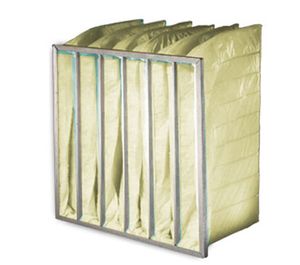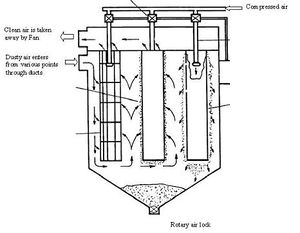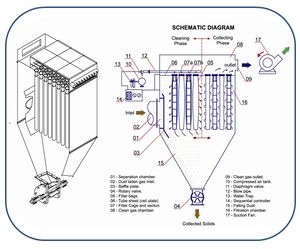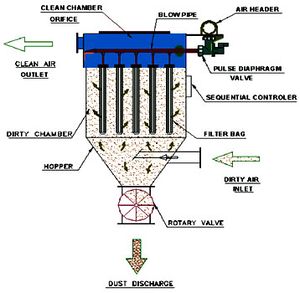Difference between revisions of "Bag Filters"
| (2 intermediate revisions by the same user not shown) | |||
| Line 7: | Line 7: | ||
* Please start editing this page after the /noinclude | * Please start editing this page after the /noinclude | ||
* -------------------------------------------------></noinclude> | * -------------------------------------------------></noinclude> | ||
[[File:Bag_filters_01.jpg|thumb|right|Bag filter]] | [[File:Bag_filters_01.jpg|thumb|right|Bag filter]] | ||
[[File:Bag_filters_02.jpg|thumb|right|Bag filtering system]] | [[File:Bag_filters_02.jpg|thumb|right|Bag filtering system]] | ||
[[File:Bag_filters_03.jpg|thumb|right|Bag filtering model]] | [[File:Bag_filters_03.jpg|thumb|right|Bag filtering model]] | ||
[[File:Bag_filters_04.jpg|thumb|right|Bag filtering system]] | [[File:Bag_filters_04.jpg|thumb|right|Bag filtering system]] | ||
A typical '''bag filter''' has a dimension of 592 mm x 592 mm and consists of 4 to 12 parallel bags. The length and depth of the bag filter varies from 300 mm up to 900 mm. Bag Filter media efficiency varies from very low (coarse filter) to very high (fine filers). The Bag filter material is made of glass or polymer fibers of different thickness or number of layers, depending on the required filter performance. | |||
A typical bag filter has a dimension of 592 mm x 592 mm and consists of 4 to 12 parallel bags. The length and depth of the bag filter varies from 300 mm up to 900 mm. Bag Filter media efficiency varies from very low (coarse filter) to very high (fine filers). The Bag filter material is made of glass or polymer fibers of different thickness or number of layers, depending on the required filter performance. | |||
A prime example of the ways in which hot gas emitting applications can contain highly risky levels of contaminants and pollutants: cremation. The bacteria and possible infections present in a dead body are many, varied and all basically nasty. You can't just burn a corpse and have the smoke wander around unscrubbed. The use of bag filters benefits a crematorium (and anyone who lives anywhere near one) by operating with 100% efficiency as part of a bespoke system, which can remove all harmful particles from the gas flow (i.e. the smoke) before it exits the smoke stack. | A prime example of the ways in which hot gas emitting applications can contain highly risky levels of contaminants and pollutants: cremation. The bacteria and possible infections present in a dead body are many, varied and all basically nasty. You can't just burn a corpse and have the smoke wander around unscrubbed. The use of bag filters benefits a crematorium (and anyone who lives anywhere near one) by operating with 100% efficiency as part of a bespoke system, which can remove all harmful particles from the gas flow (i.e. the smoke) before it exits the smoke stack. | ||
| Line 75: | Line 73: | ||
<b>Metal Working</b> | <b>Metal Working</b> | ||
<i>Applications</i>: Filtration of lubricant oil, circulating filtration of cooling water, precious metal recovery, pretreatment system filtration, Filtration of rust resistance oil ,Filtration of hydraulic oil, Filtraion of ultra precision burn-ishing oil, Oil removal of chip liquid and rinsing liquid, Parts cleaning machines use | <i>Applications</i>: Filtration of lubricant oil, circulating filtration of cooling water, precious metal recovery, pretreatment system filtration, Filtration of rust resistance oil ,Filtration of hydraulic oil, Filtraion of ultra precision burn-ishing oil, Oil removal of chip liquid and rinsing liquid, Parts cleaning machines use filter bags for minimizing residual dirt on parts. | ||
<i>Benefits</i>: Recovery of valuable catalyst, enhance operating efficiency, low operation cost and wastage, maintain the PH value of bio-materials, extend the life of biomaterials, increase the purification degree of products, protect metal processing facilities, lower operating cost, higher processing efficiency, improve the eligible rate of products. | <i>Benefits</i>: Recovery of valuable catalyst, enhance operating efficiency, low operation cost and wastage, maintain the PH value of bio-materials, extend the life of biomaterials, increase the purification degree of products, protect metal processing facilities, lower operating cost, higher processing efficiency, improve the eligible rate of products. | ||
| Line 84: | Line 82: | ||
<i>Benefits</i>: Improving polishing degree and purifying degree of products, Low investment cost and operating cost , improve product quality. | <i>Benefits</i>: Improving polishing degree and purifying degree of products, Low investment cost and operating cost , improve product quality. | ||
==Video== | ==Video== | ||
<youtube>pGFIbKhLuLo</youtube> | <youtube>pGFIbKhLuLo</youtube> | ||
Latest revision as of 03:59, 18 September 2012
A typical bag filter has a dimension of 592 mm x 592 mm and consists of 4 to 12 parallel bags. The length and depth of the bag filter varies from 300 mm up to 900 mm. Bag Filter media efficiency varies from very low (coarse filter) to very high (fine filers). The Bag filter material is made of glass or polymer fibers of different thickness or number of layers, depending on the required filter performance.
A prime example of the ways in which hot gas emitting applications can contain highly risky levels of contaminants and pollutants: cremation. The bacteria and possible infections present in a dead body are many, varied and all basically nasty. You can't just burn a corpse and have the smoke wander around unscrubbed. The use of bag filters benefits a crematorium (and anyone who lives anywhere near one) by operating with 100% efficiency as part of a bespoke system, which can remove all harmful particles from the gas flow (i.e. the smoke) before it exits the smoke stack.
Benefits
This benefit is doubled when you start to take known infections into account: any bodies cremated in a hospital or controlled environment are burned purposely to prevent a known infection or substance from transmitting into the general population. At this level of risk, a properly built and completely reliable bespoke filtering system can quite literally be a barrier between life and death, between successful containment and catastrophe. In this case, in tandem with the installation and use of the whole filtration system, the use of bag filters benefits the entire human race: without them, it simply wouldn't be possible to control the effluents that result from burning toxic or bio hazardous materials. There are some other benefits of bag filters as compared to other sorts of filters, too - a bag filter captures the particles it is taking out of a gas stream, which means that the collection mechanism and disposal unit for those particles are one and the same thing. The bag filter, when full, is simply safely removed and replaced with a new one. That's the primary way in which use of bag filters benefits a company over use of, say, wet filters or straight ceramic ones.
Application area
Petrochemicals
Applications: Filtration of lube oils, aviation coal oil, and other biomaterials, recovery of petroleum, separate polymer from benzene, recovery of activator, filtration of catalyzing oil and plasm, filtration of raw materials after open barrel, protective filtration before canned, removal of carbon ink and filter aid liquid, filtration of resin, crylic acid and pectic latex, pump protection, filtration of lube oil, petroleum and fuel additive, filtration of acids, alkalis, solvent.
Benefits: Low operating cost and energy waste, pipeline anticorrosion, low cost but added benefits through separating oils, mental, scrap material, contamination or solid substance from water, ensure stable quality of products.
Chemical
Applications: Protective filtration before canned, catalyst recovery, removal of pipe scale, polishing of aqueous process fluids, alkalis, acids and solvents, filtration of emulsions and dispersions, gel removal from resins. separate polymer in the benzene, pump protection . Activated carbon or catalyst removal in the fine chemicals industry is a typical example of a demanding application in chemical processing.
Benefits: Low cost , largely reduce treatment cost but added benefits through separating oils, mental, scrap material, contamination or solid substance from water, ensure stable quality of products.
Water Treatment
Applications: Well water filtration, water treatment plants, removal of scale and calcify materials in the water pipes, water source filtration, filtration of chemicals used in the water treatment, protect ultra-membrane and OR-membrane, retain floccules and gelatinous materials, prefiltrate purification liquid before membrane filtration, retain ion exchange resin.
Benefits: Increase heat exchange, save anti-resistant chemicals, reduce the cost of wastewater treatment , protect membrane system effectively, extend back-flush time of membrane system, extend the life of membrane system.
Pharmaceutical
Applications: Recovery of active ingredients, catalyst recovery, active carbon purification, filtration of medical used syrup, filtration of galenical extraction liquid, filtration adjust liquid of Ph value, prefiltrate crystalliferous liquid, protein removal from plasma, filtration of gelatins, hormones, active carbon, vitamin extracts.
Benefits: Reclaim valuable materials, increase the purification degree of products, improve products quality, recycle rare resource, more save, reduce labor cost and machine stopping cost; reliable filtration, reduce waster, animalcule and suspender in waste water.
Resins, Plastics, Inks and Coatings
Applications: Oil and polymer filtration, dispersions, polymerization batches, resins for can coatings, plastics compounding, printing ink, plastics processing, paper coatings, high purity ink-jet fluid filtration. filtration of raw materials as resin, etc., remove fibers and gelatins from paints, solvent filtration, filtration of particles beyond normal grade, removal of particles after com-pound reaction, removal of gluey paints coagulates, removal of oils from paints.
Benefits: Reclaimed solvent filtration, strengthen polishing degree of the resin, increase efficiency of grinding ball, low investment cost, low operating cost, improve product quality.
Automotive
Applications: Filtration of pretreatment bath, filtration of E-Coat, top-coat and clearcoat, primer, paint ring line filters, parts cleaning fluids, drawing compounds, lubricants, metalworking fluids and pump intake filters, protective filtration for ultra- filtration, filtration of degreasing craft.
Benefits: Reduce cost of machine stopping, eliminate impurity in solid and liquid, reduce holes on paint surface and decrease times of further treatment, strengthen conjoint intensity, elevate the effect of surface finish, extend the life of E-coat, prevent spray nozzles from clogging and ensure the quality stability.
Electronics
Applications: Circulating filtration of water rubbing wastewater, prefiltration of high-purity water, prefiltration of membrane model cartridge, filtration of cooling water, removal of particles from cop-per and foil eletro-bath, filtration of chemical pharmaceutical plasm, filtration of PCB printing inks, oil removal of copper and foil manufacture, removal of deposits from zinc solution.
Benefits: Increase work efficiency, simple operation, increase stability of products ,reduce filtration cost.
Paint and Lacquer
Applications: Clearing suspend curd before use, removal of fiber in external paint, removal of agglomerates, removal of paint coagulates, solvent filtration, removal of globular-grind filling and storage contaminants, filling lines, and paint mixing lines, monomer purification.
Benefits: Solvent reborn in re-collecting process, reduce cost of waste water treatment, improve operating efficiency, filtration of high quality products, avoid expensive chemical treatment, low cost and material reborn saved.
Metal Working
Applications: Filtration of lubricant oil, circulating filtration of cooling water, precious metal recovery, pretreatment system filtration, Filtration of rust resistance oil ,Filtration of hydraulic oil, Filtraion of ultra precision burn-ishing oil, Oil removal of chip liquid and rinsing liquid, Parts cleaning machines use filter bags for minimizing residual dirt on parts.
Benefits: Recovery of valuable catalyst, enhance operating efficiency, low operation cost and wastage, maintain the PH value of bio-materials, extend the life of biomaterials, increase the purification degree of products, protect metal processing facilities, lower operating cost, higher processing efficiency, improve the eligible rate of products.
Food and Beverage
Applications: beer filtration, removal of carbon black and filter aid liquid from liquid sugar, removal of particles from edible oils, protective filtration before canned, filtration of process water, syrup, and etc, removal of particles brought in adjustment craft, removal of suspended particles and deposit in beverage.
Benefits: Improving polishing degree and purifying degree of products, Low investment cost and operating cost , improve product quality.
Video



